To start with, I don't
think its at all strange for me to be excited over this project. I have always
been in awe of the Gold Wing; its quiet smooth running comfort is legendary, to
anyone who has been around motorcycles more than ten minutes. At one time, had
it not been for a discourteous salesman I would have joined the ranks of many
happy Gold Wing touring riders. I am no expert on Gold Wings or even Honda
history, most of what you will read here has been lifted out of "Gold Wing the
first twenty years". I am however in love with motorcycles and their history.
The very beginnings of this venerable machine are just too interesting to those
already in love with Gold Wing and believe it or not the rest of us motorcycle
enthusiasts. With all of this in mind let's take a look at the development of a
legend.

Honda Project 371 Test
Mule
|
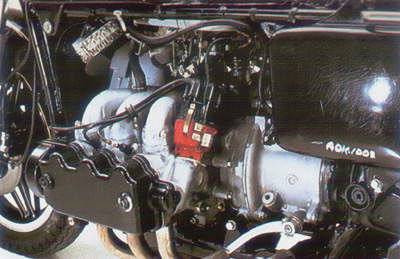
The M1's left side, the BMW
transmission can be seen. Notice the distributor and it's a six cylinder. The
reason given for the GL 1000 being only a 4 cylinder it was feared that the
market would have thought the six would be too complicated; little did they
know… |
When the Honda engineers began
building the Gold Wing they didn't have a clue what or how it would turn out.
The world of motorcycling in 1973 was still pretty raw. All motorcycles then
were air cooled and pretty simple in their design. The venerable CB 750, the
first inline 4 cylinder motorcycle was already making waves. Honda was now the
worlds largest motorcycle manufacturer and needed or wanted to have a flag ship
model and so design started.
Honda has their own way of doing things
and in so doing started out with a concept which they really had no way of
knowing what the finished product would be. They encouraged their engineers to
think outside the box and innovate.
The Gold Wing or known then at the
Honda factory Asaka-dai Japan as project 371. All of the engineers who would
head up the project had extensive experience riding, none of them racing;
although some would later move on to Honda's Racing design teams and other
projects. They were also hands on individuals who would design and test
themselves to get a better understanding of the problems with those designs.
Honda viewed their new flagship as a Grand Tourer, in the '70s that
was an abstract idea especially in Japan. Touring the long distances which the
machine has become legend was not practical; nor was it in vogue as it is
today. Looking over the competition; the BMW which just introduced their /5
models were too expensive and Harley Davidson required considerable
maintenance. But, the Honda engineers recognized the best in both of these and
incorporated them into their design.
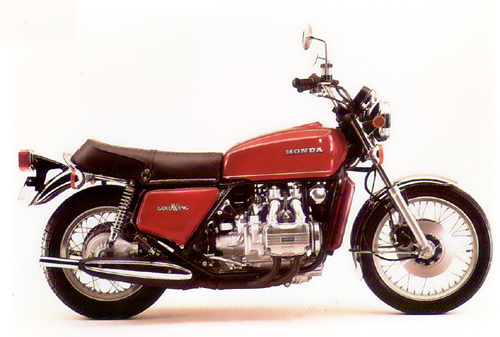
1975 GL 1000
The orignal
GL1000 Gold Wing, powered by a 999cc liquid cooled , horizontally opposed four
cylinder engine, revolutionized motorcycle touring. The faux fuel tank contains
electrical components and storage space. Spoked aluminum rims are standard.
Note the black exhaust system, with chrome heat shields and
tailpipes. |
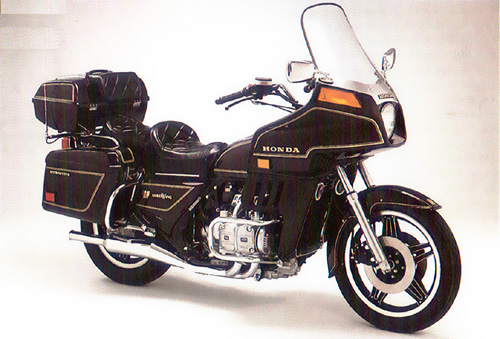
1980 GL 1100
The
introduction of the second generation GL sees the standard version joined by
the first Japanese turn key tourer, the Interstate model. Both are powdered by
a new 1085cc engine with electronic ignition; no more points. The chassis
boasts air suspension with a single inlet equalizer system at each end. Black
reverse ComStar wheels, adjustable seat, and bigger tires. The Interstate sets
new standards for touring with its full fairing, saddle bags and trunk, and
optional stereo. |
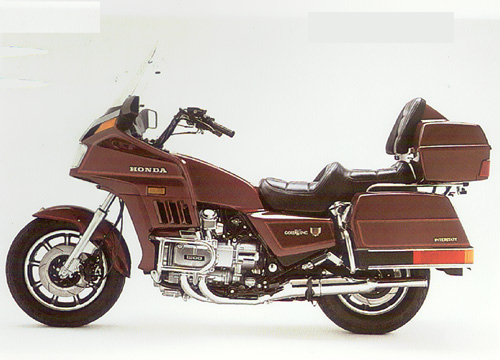
1984 GL
1200
This year sees the Wing once again rewrite the rules for touring, with
the all new GL 1200s. All three models are motivated by a new, 1182cc engine
with hydraulic valve adjustment, and a redesigned chassis sports a 16 inch
front wheel for steering lightness and precision previously unseen in the
class. The Aspencade distinguishes itself from the Interstate with LCD
instruments and special rear light bar as well as a new Type III audio system
that combines AM/FM radio bands, cassette and intercom.

GL1200
Engine |
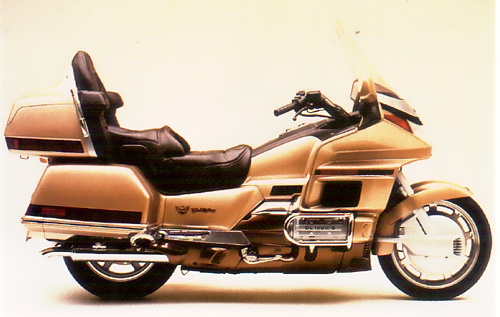
1988
GL 1500
Honda ups the ante again with the ultimate touring bike, the fourth
generation Gold Wing GL1500 six cylinder. The 1520cc six sets fresh standards
of smoothness silence and power for the class, while an all new chassis
redefines the limits of handling and comfort. A unique to motorcycling reverse
gear and single key operation of the saddlebag and trunk lids offer
unparalleled convenience. |
Some of Honda's original goals
for the new machine it had to be compact light and high performance. The design
weight was 463 lbs distributed over engine and chassis 40/60 - power was to be
61 bhp at 7500 rpms with peak torque not at its highway cruising speed but
further up at 5500 rpms. Their goal was a 13 sec quarter mile machine, faster
than their own CB 750.
You have to remember this was the 70s, the
muscle car years and performance counted. Kawasaki had already introduced the
Z1 which out ran the CB 750. None of this was lost at the Honda factory.
The very first machine they built was the M1, it would be the test
mule for their ideas. This motorcycle would later many years later show up in
bits and pieces in later Wings. It was a flat six cylinder engine motorcycle;
and a rather good looking machine. Its flat six engine and design had hidden
benefits, its lower center of gravity made the bike feel lighter than its 484
lbs. It was well liked by the testers and design team that it became the focus
of the whole design.
In fact it has become a passion at the Honda
factory ever since, mass centralization has been applied to all the Honda
models, this hasn't been lost to the rest of the motorcycle manufacturers; with
them following suit.
The original Gold Wing, the GL 1000 was
introduced in 1974, it boasted the first liquid cooled engine and was capable
of 13.0 second quarter mile times at 102 mph. Doesn't sound too quick when you
compare it to any of the 600 super sports of today but back in '74 it was hot.
Over 5000 of them were sold in the first year in the United States. Over
400,000 of them have been rolling out of Ohio since 1975.
 During it's design and testing they considered many innovative
items for the Gold Wing which at the time (1970s) were almost unheard of. Water
cooling was one and it did make it to the final design. At the time water
cooling was for cars and trucks and was generally considered to be too
complicated for motorcycles. But to insure the engines high performance and
reliability it would be necessary. The constant changing of internal clearences
from expansion and cooling of air cooled engines; their being dependant on the
air temperature cooling them, just wouldn't work for this new machine. During it's design and testing they considered many innovative
items for the Gold Wing which at the time (1970s) were almost unheard of. Water
cooling was one and it did make it to the final design. At the time water
cooling was for cars and trucks and was generally considered to be too
complicated for motorcycles. But to insure the engines high performance and
reliability it would be necessary. The constant changing of internal clearences
from expansion and cooling of air cooled engines; their being dependant on the
air temperature cooling them, just wouldn't work for this new machine.
During the testing of the new machine in the heat of an Australian
Outback Summer, warm air from the radiator was entering the intake air stream
and causing the engine's fuel air mixture to change. This wasn't apparent at
first; after all they had very little experience with water-cooled motorcycles.
The innovative new machine's air intake was on top of the engine. The faux gas
tank actually concealed the air intake system. This problem eventually led them
to raise the air intake out of the hot air stream from the radiator; but not
after some considerable hair pulling and testing.
Fuel injection was
only rejected because it was too difficult to repair in the field. An automatic
transmission with a torque converter was also designed, but it was too heavy
and made the machine too long. Antilock brakes where considered but were just
not sophisticated enough at the time. They even designed several electric and
hydraulically operated center-stand but it was just too heavy and unreliable.
 During the development it was decided that the new flag ship
machine should be shaft driven. Chain drives were messy, and required constant
attention (the o-ring chain had not been invented then) and Honda wanted the
flag ship model to be bullet proof and reliable. The M1 was fitted up with a
BMW transmission and drive shaft to speed up testing. Hirotake Takahashi was
assigned to develop a shaft drive for the machine. This turned out to take
three years; it seemed that every day they tore up his drive system. They even
developed a special method to test his designs; they called it the hop method.
A test rider would get to a pre-determined speed, put the bike in neutral and
then pop it into first gear. After three years of this torture testing, he
developed an almost indestructible shaft drive system. During the development it was decided that the new flag ship
machine should be shaft driven. Chain drives were messy, and required constant
attention (the o-ring chain had not been invented then) and Honda wanted the
flag ship model to be bullet proof and reliable. The M1 was fitted up with a
BMW transmission and drive shaft to speed up testing. Hirotake Takahashi was
assigned to develop a shaft drive for the machine. This turned out to take
three years; it seemed that every day they tore up his drive system. They even
developed a special method to test his designs; they called it the hop method.
A test rider would get to a pre-determined speed, put the bike in neutral and
then pop it into first gear. After three years of this torture testing, he
developed an almost indestructible shaft drive system.
Later on
motorcycle magazines would test the new GL 1000 only to rave about being able
to rev the engine and pop the clutch and leave with a smoking tire.
There's more to the Wing's history, it's still evolving and looking at a new
2006 you can see it's honest to its own heritage. It has become one of the
world's most recognized motorcycles and its reputation has become legendary for
its touring prowess. It has become the measuring stick for touring motorcycles.
Back to the Index of
Stories
|
